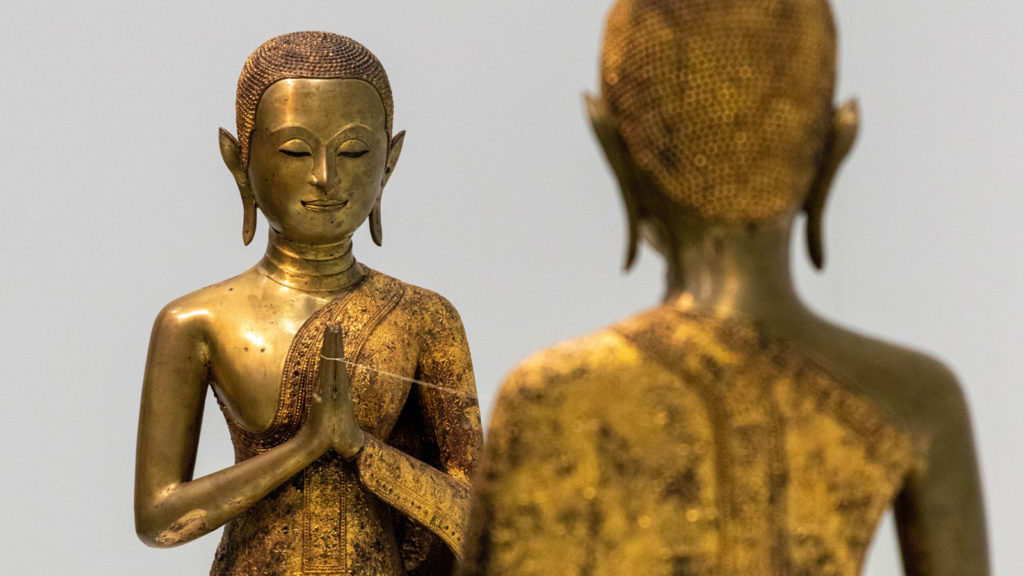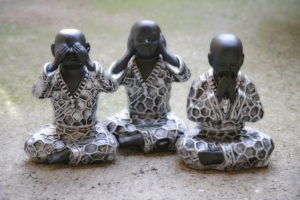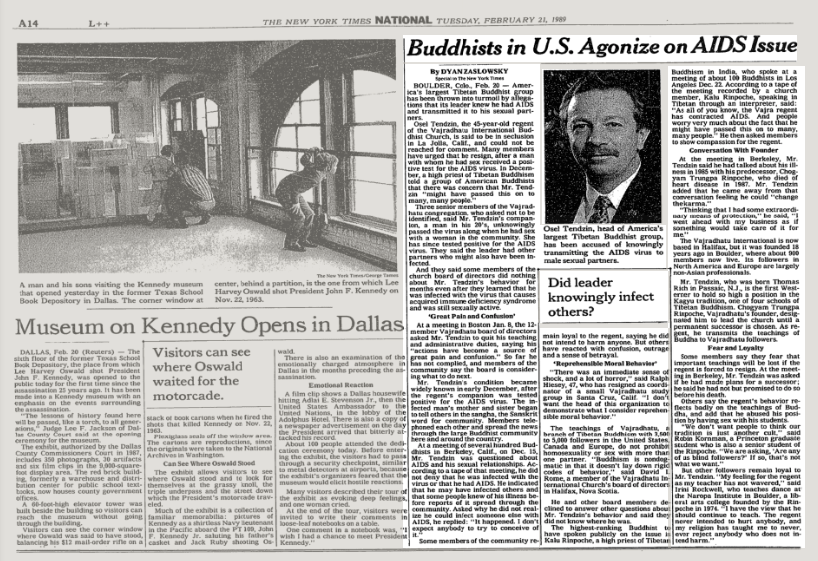The Lineage Holders: Gender, Blurred Boundaries, and Buddhism
When her Buddhist teacher pursued her romantically, she fell in love and overlooked the fraught power dynamics until it was too late
 “Breathe in difficulty, exhale compassion,” the meditation teacher said. From the back row of the packed spiritual center, I closed my eyes and followed along.
“Breathe in difficulty, exhale compassion,” the meditation teacher said. From the back row of the packed spiritual center, I closed my eyes and followed along.
At twenty-eight, I was questioning the direction of my life and feeling lost. I turned deeper into spiritual practice. Though I’d grown up vaguely Methodist in Upstate New York, Buddhism felt like home. I’d begun “sitting around” searching for community when I took a class with a young Buddhist teacher. He was brilliant and around my age. He invited me to a break-off group he’d founded, and I was drawn to its vibrancy, the way it was filled with other young seekers.
“Come back again,” he said on my way out the door. A girl with a nose ring approached, planted a kiss on his cheek.
Three weeks later while checking email, I stopped scrolling at his name.
“I don’t know many poets on the path to talk shop with,” he wrote. He’d read my poetry online, and would I want to meet for tea?
I was flattered, and curious. We made plans for the following week.
Over dinner he told me about being raised in the same meditation community as Allen Ginsberg, a favorite poet. He also practiced yoga, like me.
“I didn’t expect us to have such a connection,” The Buddhist Teacher said.
“Me either,” I admitted. Naive, I wondered if this was a date. He ordered a slice of vegan pie — two forks — and afterward we took a walk. I felt shy as he turned toward me.
“Have you always been in my city?” he asked.
“My city,” I corrected. He moved to kiss me. I pushed away.
“I don’t want to lose this community,” I said. Everything went so fast. I was attracted to him, but something inside told me this might be a bad idea. What about the nose-ring girl? Was she his girlfriend? Was it even ethical for him to date a student?
“You won’t lose the group,” he said. “Anyway, I’m less a teacher and more a community organizer.” He put his arm around me. I pushed aside my inner doubts and turned toward my hope, and him. He walked me home.
As I closed my apartment door, my studio seemed to expand. Allen Ginsberg stared from his picture on my makeshift altar. He’d lived one block away and I liked thinking his energy was still around. Now I imagined he’d brought The Buddhist Teacher and I together.
Next to Allen’s portrait, I kept a framed black and white of my family’s farm. Beneath it I’d written the word ‘sangha,’ a Buddhist term typically reserved for spiritual communities of like heart – not blood families of origin.
***
That week The Buddhist Teacher filled my phone with digital love letters. I saved them all. Yet, as I’d feared, I felt self-conscious attending the group.
“I’m glad you’re here,” he whispered in my ear when I returned. He put my cushion next to his, in the front. From this spot I watched him teach. He was knowledgeable, helping people. I was moved.
Buddhism teaches that there are three refuges: sangha (community), dharma (teachings), and the Buddha. I’d found a fourth: love.
***
I’d never shared spiritual practices with someone. As a kid, my family had only sporadically gone to church, and often I was the one who asked to go. But as I grew older, I gravitated more toward yogic and Buddhist thought, a vegetarian teen protesting as cows mooed outside my window. At night, as my developmentally disabled brother raged in the bedroom next to mine, I dog-eared pages on Buddhism’s first noble truth: life was suffering. Check. I had recurring dreams with an unseen man, hearing a message as if in voiceover — you have to find someone who shares your view of God. Yet I’d felt alone. I took my spiritual interests as another stripe of adolescent alienation, another reason to fall into goth isolation.
I’d long assumed walking the Buddhist and yogic path would mean a solitary lifelong road trip. I completed silent meditation retreats alone. I traveled to Japan by myself, sat in temples, and joked about going monastic.
It was meaningful to think of not having to go it alone. Now my boyfriend and I sat side-by-side on meditation cushions, counting our breaths. With each one we grew more attached. He invited me to dinners with his family, made plans to see me almost every night. I wasn’t used to a man being so immediately inclusive. With him came a whole world: of friends, community, and purpose.
***
Then came the parties. An introvert, I had to pace myself for the revelry of the spiritual scene.
We had parties after performing community service, when members of our Buddhist group picked plastic bags off park trees. Parties filled with cheese and beer after fasts ended. Parties where practitioners displayed their art on the walls of the dharma hall with guest speakers – authors, and lineage holders — those who inherited and carried forth the teachings — visiting. Handing me the mic, The Buddhist Teacher asked me to read my poetry aloud, to everyone. When I finished, a DJ played music.
“Who knew Buddhists were such great dancers,” he said into the mic. Everyone cheered.
“Someday we can teach here together,” he said to me privately, later, hugging a wall. He put his arm around me. We looked out at the crowd as if they were our children.
***
The more parties I went to, the more I realized girls arrived and fell away again, as if they were apparitions. I barely got to know any of them. Sometimes I felt I had moved into a frat house.
“Guess which Master Teacher’s daughter gave me a blow job on retreat?” one of my boyfriend’s friends, a fellow young teacher, asked him, giving way to stories of sexual exploits.
“This group is the only way Buddhists can get laid,” another male practitioner said. I jolted, shocked and offended.
Alcohol flowed at these gatherings. I was the only sober one. A teacher repeatedly pressured me to drink, despite my objections. I didn’t understand how one could study or meditate with a clouded mind, but worried I appeared too Puritan.
 But each question I had or offense I took was tampered every time we meditated. I felt that chime in my body — the one I associated with something Good. The Buddhist Teacher gave eloquent, layered, and helpful lectures about the dharma. We studied sutras, ancient Buddhist texts that resonated deeply with me. I pocketed my doubts and let myself be a new student, young in the tradition, grateful to have found the community.
But each question I had or offense I took was tampered every time we meditated. I felt that chime in my body — the one I associated with something Good. The Buddhist Teacher gave eloquent, layered, and helpful lectures about the dharma. We studied sutras, ancient Buddhist texts that resonated deeply with me. I pocketed my doubts and let myself be a new student, young in the tradition, grateful to have found the community.
I followed the Good.
***
When The Buddhist Teacher asked me to move in with him after a few months of dating, he held a single flower on a street corner.
“Should we wait a little longer?” I asked. Everything was going so fast.
But he reminded me — the only time is now.
In The Buddhist Teacher’s place — now our place — we meditated. Our breath, rising and falling together. I didn’t have the language for what happens in the brain when you combine neurochemicals of attraction, love, and spiritual insight, but I felt it.
I’d always fantasized about Buddhist vows, not marriage ones. Now I thought I might have both.
***
Yet as weeks went on, he grew more distant. A light had turned off. Looking at his profile at night, I had trouble making out his features. Yet in the morning The Buddhist Teacher’s face was everywhere — in magazines, on program flyers. The change in his private behavior was sudden and confusing.
I Googled contemplative courses to join away from our community, but felt too dulled to attend.
A few months later, I asked about our holiday plans.
“I’m going to my mom’s. How about you?” He asked.
I had a panic attack. Our living room spun, my heart leapt. It terrified me. After many nights of this, he said he was losing too much sleep, and needed rest to be present for his students. I could only have one anxiety attack a week, he demanded. As if I could portion out my panic. As things became strangely toxic privately, publicly he spoke eloquently on compassion — and I lost myself in cognitive dissonance. I wondered if I’d done something wrong, blamed myself. The Buddhist Teacher said he no longer recognized me. That made two of us. My panic attacks increased — I’d never before had anxiety like this.
Less than a year after moving in, he sat me down and said “we” should move out. “We” meant “me.” I watched him leave and walk to the meditation group without me.
***
He and I avoided each other while I packed my things. One night I came home to his open laptop and saw his messages with another student he was already pursuing. I scrolled, reading their sexual and romantic chat. He used some of the same phrases with her he’d used with me.
Then I found other messages where his teacher friends had written about “nice guy slut mode,” and “dharma sausage fests,” using their positions to get girls. He had forwarded private messages from me around to other men in the organization. I discovered his girlfriend before me had been a student too. I felt sick.
But when I confronted him, he threatened to ostracize me. “If you come to the group, I’m shutting it down,” he said. I went away.
I moved out, devastated. This man, I’d thought, had been different. He’d watched thoughts pass like clouds. I did not want to be a cloud.
I was determined not to lose my spiritual practice. I needed to meditate.
Yet each time I tried I was hit with a surprise — overwhelming anxiety and grief. The practice itself — even the language I’d once found grounding — was now infused with pain.
With Buddhism now triggering, I turned deeper into yoga. I signed up for teacher training at a studio and began teaching yoga at an all-girls elementary school. I tried to create a safe, empowering space for the girls. Still, each night I fell onto my own yoga mat feeling secretly broken.
“I remember you,” a yogi came up to me one night. “You used to go to the Buddhist group, right? I heard the teacher has a problem with monogamy.”
I learned more about The Buddhist Teacher’s lineage. The founder, alongside his books and teachings, had been an alcoholic and womanizer, pursuing sexual relationships with students. After he died, his successor also slept with students, knowingly passing on HIV. There had been a whole culture of crossed teacher/student boundaries, sexism, grooming, and power abuse. And silence.

The New York Times, 1989.
As I researched other communities, these stories were everywhere.
I gave up Buddhism, grieved it. I felt ashamed abandoning it, worried I was weak. I stayed alone, didn’t date. Now when I unrolled my yoga mat, it was often to escape. But the pain always came back. I wondered if you could get trapped in the pursuit of healing instead of transforming through it.
I was afraid to say anything or ask for guidance within mindfulness communities — my ex had done a good job connecting them through his work so none seemed neutral or safe. He was revered, and I worried about backlash even in asking questions. I turned into an urban ascetic — practicing and teaching yoga, praying, going home to my studio apartment just to wake up and repeat. The illumination I’d found in Buddhist teachings, along with my self-confidence, dimmed.
***
“Who digs Los Angeles, IS Los Angeles.” – Allen Ginsberg
When I was offered a job to help coordinate a university yoga program in Los Angeles, I grabbed the opportunity and left my life in New York.
There, on the other side of the continent, I’d start over. I’d be 3,000 miles away from this story.
The sun would be bright, the world changed.
Yet once I arrived I quickly encountered several local Buddhist and yoga communities also rocked with inappropriate teacher/student relationships, upsetting power dynamics, and outright sexual misconduct.
Here I was — gone — but the narrative wouldn’t leave me.
“In our community we need to prevent this” a colleague said. He mentioned the word “Brahmacharya,” a Sanskrit term and part of yoga’s ethical guidelines, meaning ‘sexual responsibility.’ But whose responsibility was it? Mine?
In what felt like karma, I was tasked with creating a code of conduct for our yoga program, including strict teacher/student protocols. I underwent Title IX training. In academic settings the boundaries were clear: the moment a student walked into a room with a teacher, power dynamics were at play. No official “vow” was needed to establish a teacher relationship; students are seeking and therefore vulnerable. I wanted the same clarity in spiritual spaces, where vulnerability was heightened, where not only an open mind was needed, but openness of spirit and, in yoga settings, the body too.
***
One day, a young female student came to see me.
“I’ve gotten myself into a situation,” she said, recounting a relationship with a teacher in her studio. The nuances were similar to my experience and others I’d witnessed.
I comforted her but was livid. Why were these indiscretions so common? Being a teacher myself, I now saw the issue from both sides. I understood the onus of boundaries was on the teacher, and I knew the long-term harm breeching them could cause. I knew how confusing this could be — as seekers we were taught to follow teachers, often over our own inner thoughts. We were told that was how we’d learn. I was grateful to be able to advocate on her behalf, but angry I had to do so. I listened to her.
I was proud to help, but secretly drained. After she left, I closed the door to my office and lay on a yoga mat to breathe.
Almost a decade after I’d walked into The Buddhist Teacher’s class, I decided to start speaking to other women about my experience. I was shocked — after years of feeling alone, I saw I wasn’t. These stories were incredibly common. All sorts of misconduct had been taking place. I began to see we were holding a lineage, too.
Then I reconnected with an old friend from the yoga studio where I’d found shelter after The Buddhist Teacher. I told her that place “saved” me. I was so glad it had been safe.
She told me it, too, had been rocked with sexual misconduct and was now closed.
***
Each night in L.A., I drove home past the SONY lot where they’d filmed the Wizard of Oz. I began to think about what was behind curtains. The university where I worked was Catholic — and I’d been well aware of sex scandals in the Catholic Church. In contrast, I had thought of Buddhism as inherently safe. I had so deeply wanted to believe places of healing were free from harm. As a new student I’d ignored my own doubts and deferred to those in power.
But now I understood: The Buddhist Teacher and others in leadership had an inherent responsibility not to abuse the power they had. Clear boundaries were part of the job.
As the New York Times broke the news that the head of my ex’s school had sexually assaulted his female students, I was upset but not surprised. This was a systemic issue of power abuse, generations old. I now understood my panic attacks had been a visceral reaction to a larger knowing — my body’s urge to get out.
As I drove past the Hollywood studios, I turned my car toward my new home, the Western sky wide and warm and different. I wasn’t on a solitary road trip at all. I was part of a powerful community of female seekers.
Maybe, in this case, healing wouldn’t come from sitting in meditative silence. It would come from speaking, and being heard.
Sarah Herrington is a writer, poet, and yogi. She helped establish the first Master of Arts in Yoga Studies in North America at Loyola Marymount University. Her work has appeared in the New York Times, Yoga Journal, and she’s the author of four books on yoga. She is currently writing a memoir.
***
Published with support from the Henry R. Luce Initiative on Religion in International Affairs.